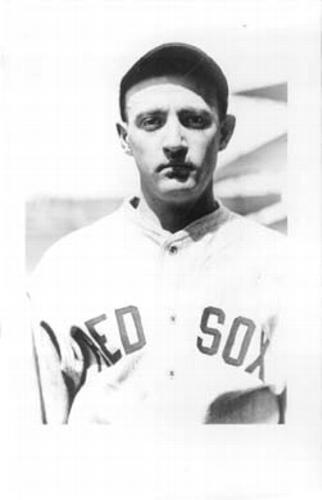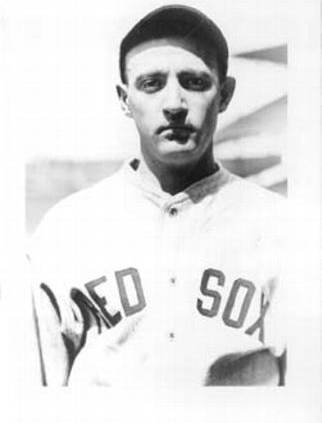September 12, 1931: Fenway Park pigeons play a role in 1-0 Red Sox win in 13 innings
 In mid-September of 1931, the Philadelphia Athletics were running away with their third straight American League pennant. On the morning of Saturday, September 12, the Athletics had a 13-game lead over the second-place Washington Nationals with just 15 games to play. The Boston Red Sox were dead last of eight AL clubs, 44½ games behind Philadelphia. The Detroit Tigers were sixth, 39½ games out.
In mid-September of 1931, the Philadelphia Athletics were running away with their third straight American League pennant. On the morning of Saturday, September 12, the Athletics had a 13-game lead over the second-place Washington Nationals with just 15 games to play. The Boston Red Sox were dead last of eight AL clubs, 44½ games behind Philadelphia. The Detroit Tigers were sixth, 39½ games out.
Both Shano Collins’s Red Sox and Bucky Harris’s Tigers were long since eliminated from the pennant race, but there was still pride to play for, as they faced off in a three-game series at Boston’s Fenway Park. On Thursday, September 10, the Tigers shut out the Red Sox, 3-0, Tommy Bridges beating Wilcy Moore. On Friday it was the Red Sox who shut out the Tigers, 5-0, with Danny MacFayden allowing just three base hits. The losing pitcher was Orlin Collier, in his major-league debut.1
The series finale featured opposing pitchers going the distance in a 13-inning game. Pitching a complete game was far from unusual in that era. By year’s end, Tigers pitchers had thrown 86 complete games and Red Sox pitchers had 61.2 Still, only five AL pitchers – including Boston’s Ed Durham and Detroit’s Arthur “Red” Herring in the September 12 game – worked into the 13th inning for complete games in 1931.3
A flock of Fenway Park pigeons played a role in what proved a pitchers’ duel, in front of a crowd of about 4,000.
For the first four innings, the Tigers were denied a baserunner against the right-handed Durham, who was in his third season with Boston. He’d lost his last two starts and was 5-9 with a 5.26 ERA. The first Tiger to reach base was first baseman Dale Alexander, who led off the fifth inning with a single but was cut down trying to reach second base.4
Like Durham, Herring was in his third major-league season. Also a right-hander, he was 5-10 with a 4.62 ERA. Red Sox left fielder Jack Rothrock led off the bottom of the first with a single but was erased by a double play. Second baseman Marty McManus singled in the fourth and reached second on an error, but got no farther.
The Red Sox had a chance to break through when first baseman Bill Sweeney and McManus singled to start the bottom of the sixth, putting runners on first and second with nobody out. But right fielder Earl Webb – already with 59 doubles in the season, just five shy of George Burns’s all-time American or National League record – hit into a 4-6-3 double play and center fielder Tom Oliver popped up to second base.
Detroit mounted its biggest threat in the top of the seventh, starting with a one-out single from left fielder John Stone. Alexander drove a ball that looked as though it might drop in for a hit, but, as the Detroit Free Press reported, “center fielder Tom Oliver dashed far to right center and made the catch when it was evident that Right Fielder Earl Webb didn’t have a chance to get the ball.”5 There followed a two-out single by center fielder Gee Walker, but the inning ended with the game still scoreless.
Herring singled in the top of the eighth, but nothing came of it. Rothrock led off the bottom of the eighth with a triple over Roy Johnson’s head in right, but Sweeney grounded out 6-3, Rothrock having to hold at third. McManus hit the ball back to Herring, who threw to third and got Rothrock out. Webb singled, but Oliver hit into a force play to end the threat.
Both teams singled in the ninth, but neither got the runner as far as second base.
The pitchers continued to hold the upper hand as the game went into extra innings. Durham retired the side in order in the 10th, 11th, 12th, and 13th, setting down the final 13 Detroit batters he faced. In the 13th, the Tigers’ Walker struck out and was ejected by plate umpire Bill Guthrie for calling him a “fat head” – even though each of his three strikes had been swinging strikes.6
Herring walked one in the 10th. Oliver singled to lead off the 11th for Boston but, after two batters failed to advance him, was caught stealing. The Red Sox went down in order in the 12th.
Then the pigeons came into play. Sweeney led off the bottom of the 13th with a fly ball to right-center field. The Detroit Free Press described how the play unfolded:
“It seemed a routine catch for Roy Johnson. Just as he had his eye on the ball for the catch, up jumped a flock of pigeons. The birds flew in front of Roy, bothered his vision, and he apparently lost sight of the ball. It fell off the tips of his fingers as a two bagger.”7
The Boston Herald was perhaps more familiar with the birds:
“That homelike and famous band of Fenway Park pigeons helped the Sox to make their one run in the 13th. Bill Sweeney was first man up. He sent a fly toward right field. The fleet Roy Johnson scampered along and got under the ball. Up from the smooth green grass of that territory flashed a covey of pigeons. They flew between Johnson’s vision and the little white ball. It bothered him. The ball fell, yet Roy must have taken his eye off the apple. It fell off the ends of his fingers and Sweeney pulled up at second base. Johnson picked up the ball and made a wild, hurried throw back toward his infield. The throw was too high and too strongly propelled. It went to the grandstand and Sweeney raced to third.”8
It was scored a double and an error on Johnson, and the potential winning run was on third with none out. Herring struck out McManus and issued an intentional walk to Webb, whose pregame .332 batting average and .533 slugging percentage were easily the best on the Red Sox.9
With runners on first and third, Oliver lined a ball to right field, near the foul line. Johnson made something of a spectacular catch – while “going at top speed [he] made a one-handed scooping catch of the ball down around his ankles, and then, before he had fairly straightened up, shot the ball to the plate, but Sweeney, who is very fast, just beat the throw home, the ball coming to [catcher Muddy Ruel] on the first hop, and a little high.”10
The Gene Mack sports page cartoon in the Boston Globe the next day depicted a number of the plays, including the play at the plate, though it oddly omitted the pigeons.11
Durham had held the Tigers to five scattered hits in 13 innings; he never walked even one. Only two Tigers reached second base, one of those due to an error. Herring struck out seven Red Sox in 12⅔ innings.
The win was Durham’s second major-league shutout. Nine days later, he booked his third, shutting out the St. Louis Browns, 2-0, at Fenway Park.
The Chicago White Sox came to Boston on September 13 and won the first game of a Sunday doubleheader played against the Red Sox at Braves Field, 6-5.12 The two teams played 14 innings in the second game before the game was called because of darkness with the score 2-2.
Finishing 11-5-1, Boston climbed up to sixth place; Detroit finished seventh. One difference between the teams was their performance in extra-inning games. The Tigers finished the season 8-11 in extra-innings, while the Red Sox had a superb record of 12-3-1. Ten of those 12 wins were home wins; they lost only two extra-inning games at home.13
Acknowledgments
This article was fact-checked by Thomas J. Brown Jr. and copy-edited by Len Levin.
Photo credit: Ed Durham, Trading Card Database.
Sources
In addition to the sources cited in the Notes, the author consulted Baseball-Reference.com and Retrosheet.org for pertinent information, including the box score and play-by-play.
https://www.baseball-reference.com/boxes/BOS/BOS193109120.shtml
https://www.retrosheet.org/boxesetc/1931/B09120BOS1931.htm
Thanks to Nathan Bierma for access to the Detroit Free Press.
Notes
1 Collier pitched only one other game in the majors, giving up seven runs to the Cleveland Indians, but leaving the game in the sixth before his teammates came from behind and scored four runs to win, 9-7. The win went to Art Herring.
2 Danny MacFayden led with 17; Earl Whitehill of Detroit threw complete games in 22 of his 34 starts.
3 Roy Sherid of the New York Yankees pitched a 15-inning complete game but lost to the Red Sox on April 18. Jack Russell of the Red Sox took a 13-inning complete-game loss to the St. Louis Browns on June 27 when Larry Bettencourt led off the bottom of the 14th with a home run. Detroit’s Vic Sorrell won a 13-inning complete game over the Nationals on September 19.
4 Alexander was dealt to the Red Sox during the 1932 season (with Roy Johnson, both in trade for Earl Webb) and became the team’s first AL batting champion that year, finishing with a .367 average.
5 “Tigers Lose in Overtime,” Detroit Free Press, September 13, 1931: 45.
6 James C. O’Leary, “Red Sox Defeat Tigers by 1 to 0,” Boston Globe, September 13, 1931: 43.
7 “Tigers Lose in Overtime.”
8 Burt Whitman, “Red Sox Defeat Tigers, 1-0, in 13 innings,” Boston Herald, September 13, 1931: 1.
9 Webb went on to hit 67 doubles in 1931, which remained the record for an American or National League player as of 2024.
10 O’Leary.
11 Gene Mack, “Who Said 13 Was Unlucky?” Boston Globe, September 13, 1931: 43.
12 Sunday baseball had been permitted at Braves Field since 1929, but Massachusetts law did not allow it at Fenway Park until the 1932 season, because Fenway was closer to a nearby church.
13 With 12 of the team’s total of 62 wins being earned in this fashion, that means that just over 16 percent of their wins in 1931 were in extra innings at home.
Additional Stats
Boston Red Sox 1
Detroit Tigers 0
13 innings
Fenway Park
Boston, MA
Box Score + PBP:
Corrections? Additions?
If you can help us improve this game story, contact us.


